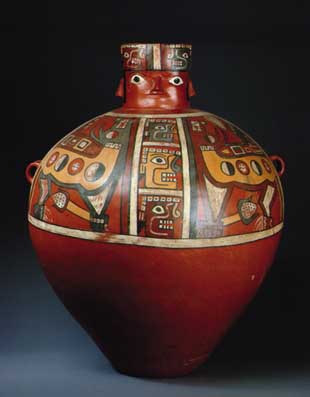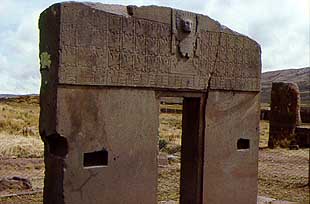|
The Wari culture (600-850 A.D.) belongs to the most important prehistorical cultures of Peru. It developed in the mountainous valley of Ayacucho in Central Peru on the basis of local traditions and the influences carried by the Tiwanaku culture that flourished in the
altiplano of Bolivia. The centre of the culture was the city of Wari, whose massive ruins cover an area of circa 10-15 square km.
The Wari influence spread to a large area. The centres of Viracochapampa and Pikillaqta are situated 700 km north and 250 km south-east from the city of Wari. Their impressive ruins, like the rich Wari artefacts of Peru´s south and middle coast tell about the prevalence of the culture. Because of a uniform cultural image the Wari period is called the
Middle Horizon.
The Wari state has traditionally been seen as warlike in nature, and it has created its large sphere of power with the help of political force. Wari was probably the first centrally governed state of the Andes and it formed the basis for the Inca state. Among other things, large maintenance of tax workers and the existence of central administrative network that focused on control plus building an extensive network of roads point to the centrally governed and efficiently organized nature of the state.
The Wari state seems to have blossomed out in rather short a time. However, a rapid rise was followed by almost as rapid a downfall, the reasons for which are yet unknown. The Wari city itself was abandoned round about the year 800 A.D., but, among others, the centre of Pikillaqta seems to have outlived its capital for 100-200 years. In art also the Wari influence lived longer than its former centre.

Large jars decorated with human faces are among the most typical and impressive Wari vessel shapes. Wari vessels are typically richly paint-decorated and beautifully
smoothed. © Museo Nacional de Arqueología, Antropología e Historia del Perú
- Instituto Nacional de Cultura del Perú, Lima, Peru (Cat. 272)
|

The Wari culture took up several basic features of its religion and iconography from the Tiwanaku culture. The picture presents the highest deity of the Wari-Tiwanaku religion, the Staff God, dominating on the top centre of the Sun Gate, an important portal in Tiwanaku, surrounded by his winged
messengers. © Antti Korpisaari
|

